Article
How to Photograph Your Car
Author(s):
Aside from one's children, your house and your car are the most valuable items and thus shutterbugs want to photograph them. But how do you accurately capture the personality of a car in a photograph?
Editor's Note: The author has been a member of the Motor Press Guild for more than 20 years. He photographed automobiles for many physician magazines including Private Practice, Physician’s Management and Medical Tribune. He was the automobile editor for several years for the tabloid Physician’s Financial News.
In the days before digital photography the most common items photographed were supposedly your home and your car. The president of our photography club once told me, those were the most expensive items we owned and our ownership was best shown by a photo. The parent in me never accepted this and now where every person has a convenient camera in every smartphone, it seems clear what we constantly do is photograph our children (who in every sense of the word really are our most expensive items).
But back to cars. We do it all wrong, a professor once told me at the Brooks Institute, then in Santa Barbara, (now Ventura, CA). The best time to photograph a car, he said, is as the sun goes down but not to shoot into the sunset and have to use fill-in flash. Instead, have our backs to the sun and let the alpenglow paint all over the metal and make the car come alive.
I understood his point and he had some gorgeous prints to show me that illustrated this belief. A team from the famous Brooks Institute had just returned from Turin, Italy where it was one of the scientific teams that had photographed the Shroud of Turin using four tons of equipment. Of course, we usually have much simpler equipment when we photograph our cars. That said, it’s actually easier to photograph your car — or any subject for that matter – with the sun at your back than shooting into the sun though you will miss all those artsy-crafty sunsets.
The basic rules of car photography might be
• Wash the car first and, if you are shooting interiors, clean them up and particularly dust them or wipe them with a damp cloth.
• Keep your backgrounds simple and don’t let them compete with the car.
• If your background color works with the car’s color, so much the better.
• Don’t crop the image too tightly. Leave more room in front than behind.
• For a broadside view have all the windows up or maybe even down but not half and half. Have shadow-free light hitting the entire side.
• A front three-quarter angle always seems better than a rear three-quarter shot. Some cars, like humans, have really unattractive rear ends!
• If you are photographing a car to sell it, shoot the driver’s side so customers can imagine themselves in it.
• Convertibles always look better with tops down.
• Unless it’s a very bright day try putting on the car’s lights.
• If you are on a driving vacation, try to show some of the location.
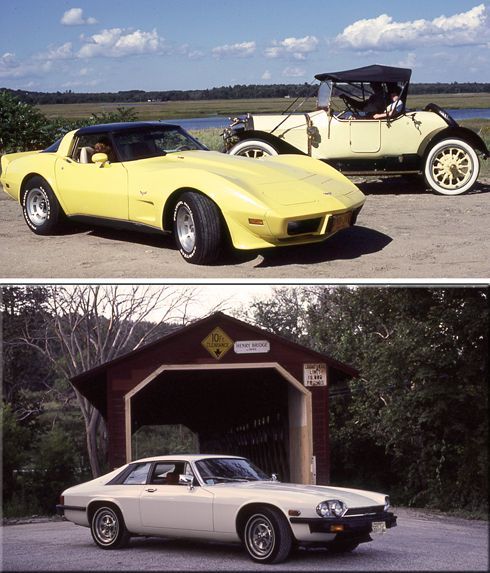
A Corvette and a 1912 Pathfinder at Wells Auto Museum in Maine; Jaguar XJS, 12 cylinders and — on a 2,000 mile trip through the US Northeast — 12 miles per gallon.
Already I’m breaking the rule that favors the driver’s side but images in the old days for print magazines often had the right side of the car showing — if it was intended for the left hand page of the publication, then it would be facing the fold. I’m not pleased with how tight I cropped many of the slide images. My Epson V500 Photo scanner tends to crop slides a bit tight but now it’s so seldom used I have become somewhat cavalier about that.
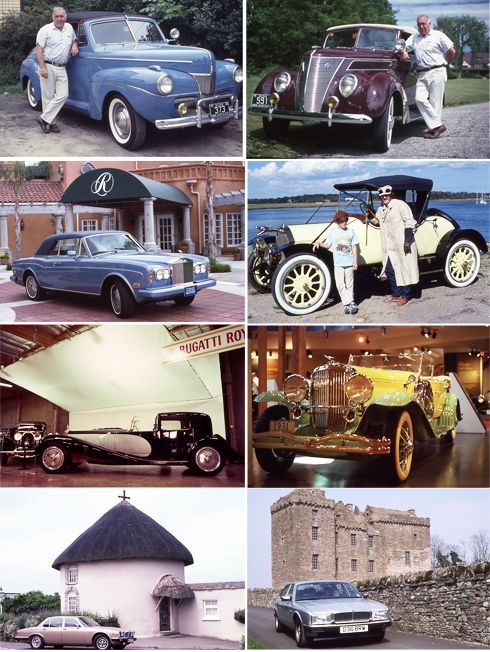
Show Car Owners: If you have a friend with an antique car include the owner in the photo, as I’m done here with my old friend, the late New Hampshire surgeon Sam May, MD, and his antique Fords. The Rolls-Royce convertible was photographed at the Remington Club, Rancho Bernardo, CA, with its owner’s blessing. Again, the 1912 Pathfinder Wells Auto Museum in Maine. The owner of “the most expensive automobile in the world,” the Bugatti Royale, was the Harrah’s Collection, now the National Automobile Museum in Reno, NV and the original owner of the Heritage Museum, Massachusetts Duesenberg was Gary Cooper. I photographed most of my Jaguar shots in the UK, the one bottom left at Veryan, Cornwall and bottom right in front of Huntingtower Castle, near Perth, Scotland. For the so-called romantic story of medieval Huntingtower click here. The Veryan Round Houses were built around 1817 by Parson Trist for each of his daughters, in a round shape to keep them safe as there were no corners in which the devil could hide.
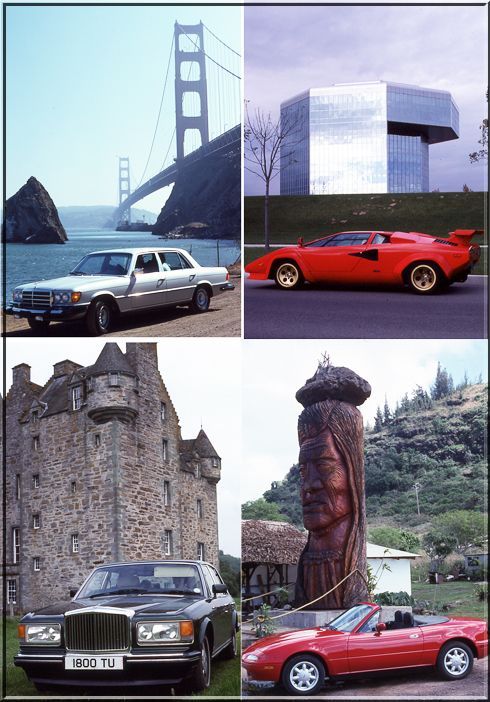
Backgrounds may remind you of your vacations, here a Mercedes-Benz 450SEL at the Golden Gate Bridge, San Francisco. A Lamborghini Countach in Southern California. A new Bentley sedan at an old Scottish castle and a prototype Mazda Miata in Oahu.
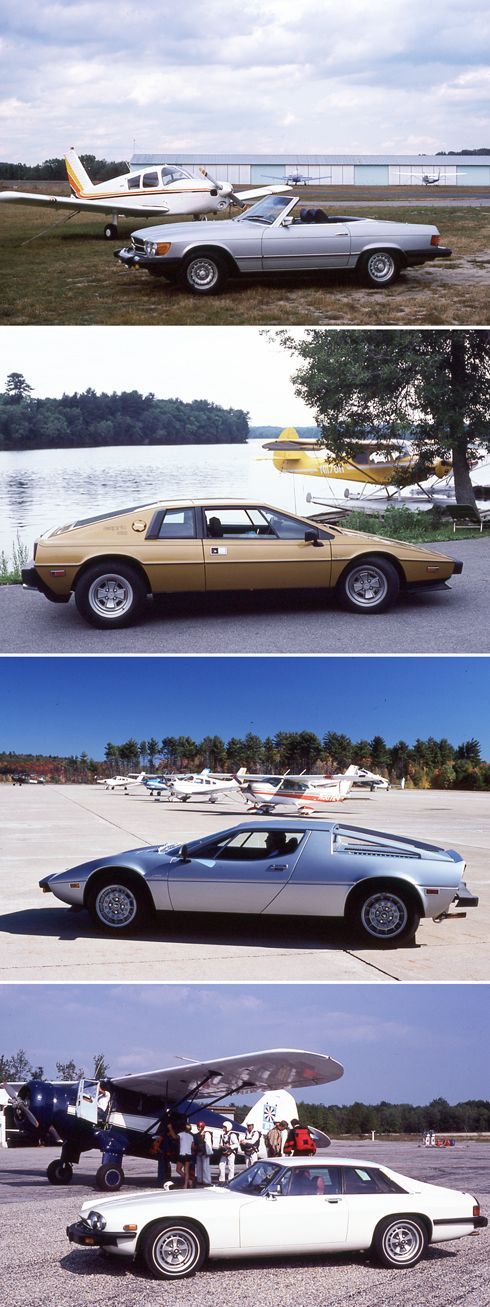
Small airports can give clutter-free tarmacs and you can be choosy finding an appropriate airplane. Here Margaret, my late wife’s, Mercedes-Benz 380 SL that she drove for 21 years; A Lotus Esprit on a river bank; a Maserati Merak, arguably the most beautiful automobile ever made. (Its rival was always the Ferrari but if you parked a Maserati beside a Ferrari the crowd would always gather around the Maserati.) Again a Jaguar XJS.

A Maserati Merak enjoying fall foliage on Cape Cod. A Ferrari Mondial in Modena, Italy. A Jaguar Daimler outside my old high school, Morrison’s Academy in Crieff, Perthshire, Scotland. A BMW M1 on the autobahn in Germany. Its top speed scare the pants off me. The top image compared to the bottom one shows how the background in Cape Cod can dominate whereas the simplicity behind the M1 allows the car to show itself, red against green.
Cars are created for a reason. Few could afford a genuine classic car 50 years ago, so a market for replica cars sprang up. The Excalibur Automobile Corporation of Milwaukee, WI was created in a curious turn of events a half century ago. Brooks Stevens, a styling consultant at Studebaker, conceived a car based on the 1927 Mercedes-Benz SSK Roadster. He hustled the car for the 1964 New York Auto Show “to give Studebaker a dying glory.” It mesmerized all who saw it including Gerald Allen, at that time a New York City Chevrolet dealer. Stevens had never thought of this car as a viable commercial product but Allen told him, “If you take out the Studebaker drive train and put in a Chevrolet, I’ll buy 25 right now.”
At the time I met Allen in the early 1980s he himself was selling about 40 a year and the company about 300 annually which at the time actually made it the fifth largest American automobile manufacturer! And with Chevrolet parts for this Mercedes replica, its maintenance was a lot cheaper. A physician once told me his Mercedes 450SL was “his private charity, he was putting so much money into it each year.” About the same time, a publicist for Mercedes told me the best thing that ever happened to her company was Lexus. She explained it reduced the arrogance of her company’s dealer. In 1991 Lexus outsold both Mercedes Benz and BMW to become the best-selling luxury import brand in America. The Dodge Viper, on the other hand, was not created to compete with another car maker, but rather to overwhelm the asphalt, so maybe that’s its best background. The Hummer, however, was brought forth to dominate the terrain (here photographed in the Californian desert). For the Mercedes-Benz 420SEL, I found a parking lot at a new housing development that was as pretty a stage setting.
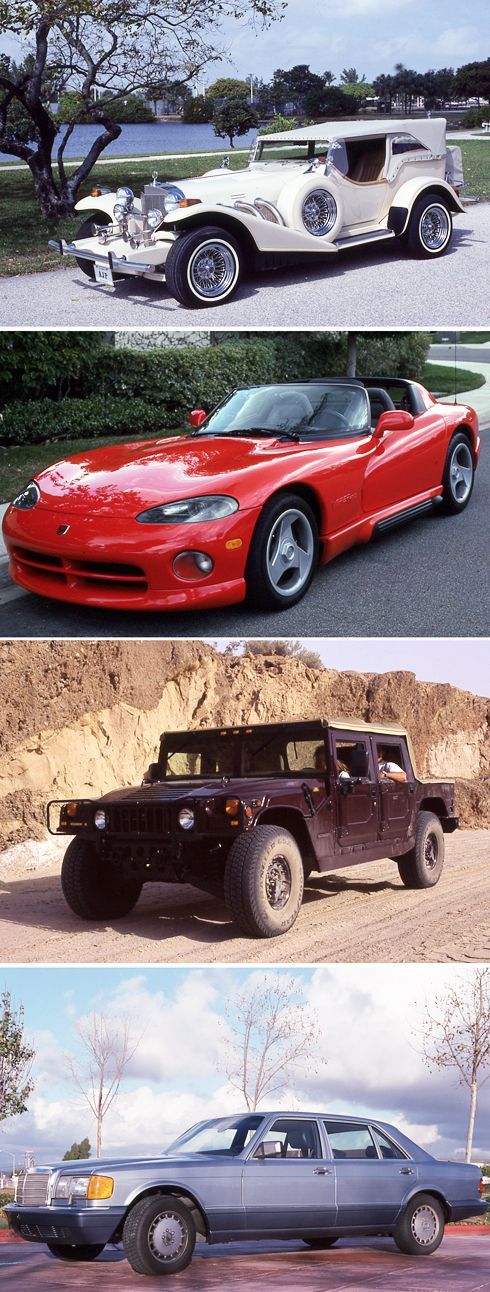
Excalibur — you have to be an extravert for this, and maybe for a Dodge Viper too. Hummer in Californian desert. Mercedes-Benz 420SEL.

Chevrolet Blazer 4WD in Death Valley, Corvette in New England, Jaguar Daimler in England’s West Country at Land’s End, Jaguar XJS in England to show how a slight uphill stance makes a car look more powerful. Maserati Merak broadside view with even shadow-free illumination, windows up (beautiful car to photograph — but it broke down and my wife had to drive 70 miles to collect me).
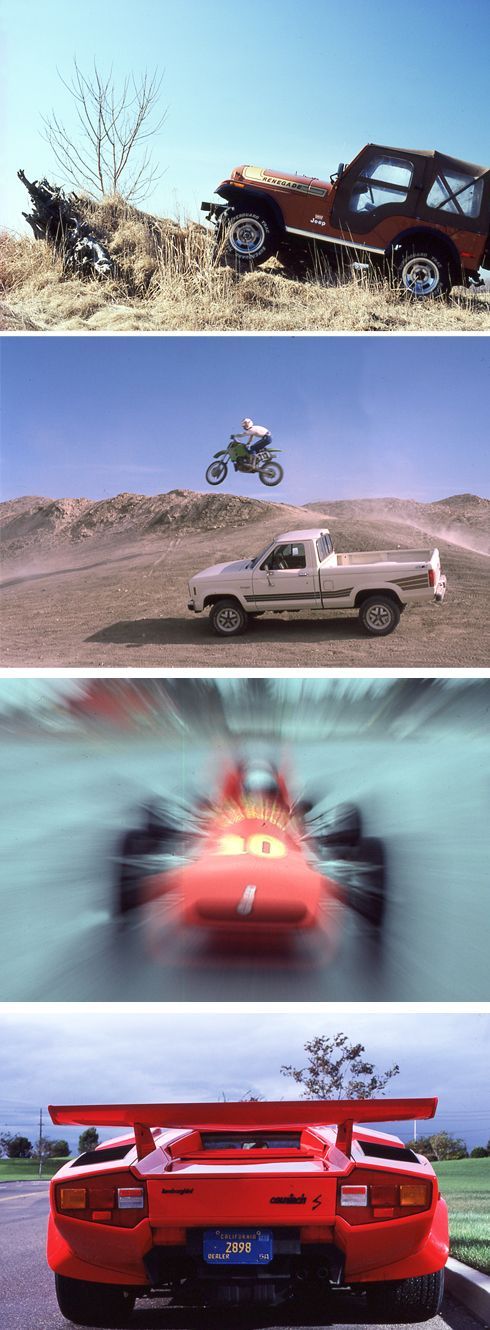
Cars are like statues—immobile and possibly boring. You can deal with that by having a chase car to photograph the vehicle while it’s moving or having the car drive past you while you swing the camera and lead and follow the car. Some sense of motion can be given if you stage the scene, here with a Jeep CJ5 that looks as if it has run out of road. There’s motion too in my son Michael’s truck/motor bike shot and in my zoom shot (you need a tripod and just experiment with the zoom and a slow shutter speed. Then sometimes the rear end of a Lamborghini Countach looks as if it’s taking off. Owners say they can get a speeding ticket even when they are stationary.

Images to show some further points: Auburn Speedster built only 500 cars (1935-36) but Glenn Pray of Broken Arrow, OK subsequently built about 15 “second generation” models per year in the early 1980s. He died in March 2011. The top two images contrast a front three-quarter view with the Speedster in shade and a broadside view in full illumination. Both work because they are a rural location that could be of the Auburn era.
The next two images are of the Aston Martin Volante, hood down and hood up. The second image is improved by having the headlights on. The next image of a Lotus Esprit also has its lights on and both cars benefit from a low viewpoint. I put in the Acura NSX simply because it was such a great sports car, like a Ferrari but one with electricals that worked — but it’s not a particularly good photo. The Jaguar at the little Perthshire village of Fowlis Wester shows how easy it is to imply a location and it’s just five miles from where I was born in Crieff.
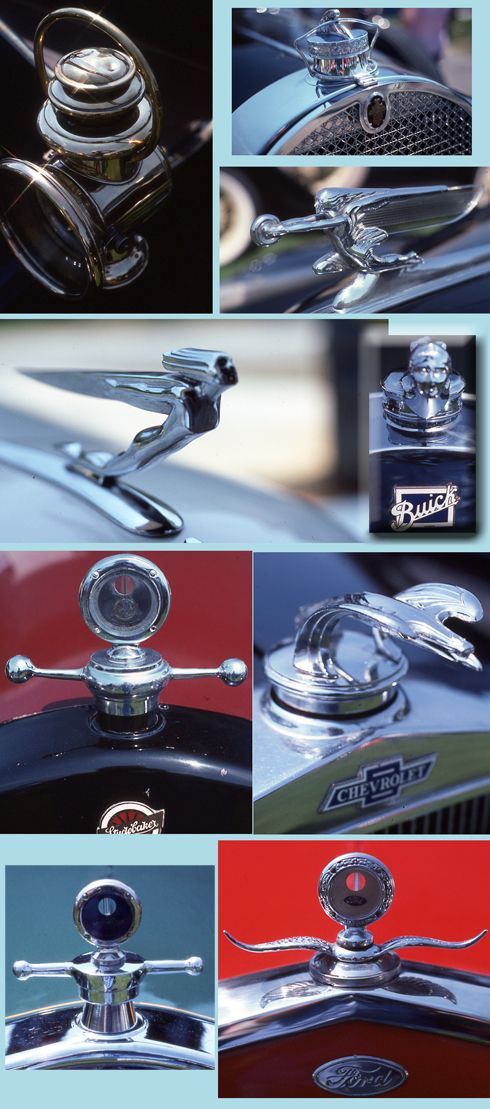
Don’t forget if any antique car shows come your way how easily their hood ornaments become photographs. From top right: Packard, Packard, Buick, Chevrolet, Ford, unidentified, Studebaker, Auburn.
David Newhardt, a friend at the Motor Press Guild and the chief photographer for Mecum Auctions reminds us not to skip a car’s interior. “Try to be aware of the view out the windows,” He says. “If you can see bright sun in the background, the exposure of the interior is going to suffer.” He has been a professional photographer for 30 years with experience at Motor Trend and with 16 automotive books. He feels we miss fun stuff sometimes. “Shoot the cool details” he tells us. “Most automobiles and trucks are a rolling collection of neat details, and that includes the inside. Instrument panels with space-age displays, shifters that resemble sculpture more than machine, radio faces that ooze character —these elements are some of the eye-candy that carmakers once lavished onto their creations.”
French writer Roland Barthes (1915-1980) once said, “Cars today are the exact equivalent of the great Gothic cathedrals.” He must have been talking about the classic cars of his era, not our present time, and indeed some cars of the 1930s really were gorgeous and when we see one we understand why Hollywood celebrities had to have them.
Ken Behring, a wealthy real estate developer and world-famous philanthropist understood that. Behring started his successful career as an automobile dealer in Wisconsin, then created numerous planned communities in Florida and California including the one at Blackhawk, an hour east of San Francisco in Danville, CA. As the owner of the Seattle Seahawks football team, he pledged $20 million to the Smithsonian Museum of Natural History and, in 2000, an additional $80 million to rebuild the Smithsonian's National Museum of American History.
In his own Blackhawk Museum he created a gorgeous setting for his car collection. It's all brushed stainless steel and plate glass standing on massive galleries of black, ruby and pink Italian granite, lit by copper-hued German skylights and discrete lights that make the gallery interiors glow like a jeweler's case. There are no backdrops, just black walls and ceilings that, with the stage lighting, both dramatize the cars and make photography difficult.
Behring had a passion for cars and one of his prides was Clark Gable’s 1935 Duesenberg Model JN Convertible Coupe. This is automobile as art — and that memory, that epiphany, follows me all the way back to San Francisco in our 10-year-old Prius.
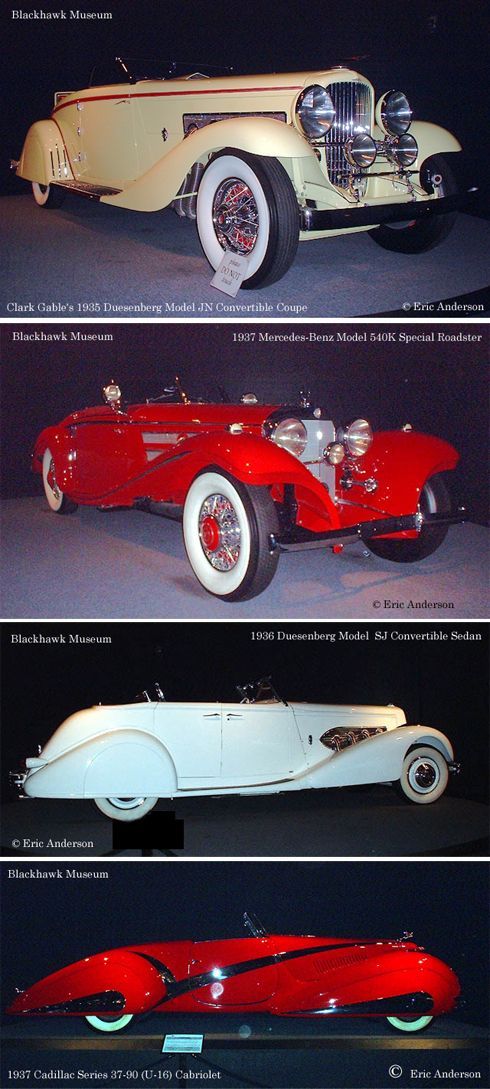
Gable’s 1935 Duesenberg; 1937 Mercedes-Benz 540K Special Roadster; 1936 Duesenberg SJ Convertible Sedan; 1937 Cadillac 37-90 (U-16) Cabriolet.
Photography by the author
The Andersons, who live in San Diego, are the resident travel & cruise columnists for Physician's Money Digest. Nancy is a former nursing educator, Eric a retired MD. The one-time president of the New Hampshire Academy of Family Physicians, Eric is the only physician in the Society of American Travel Writers. He has also written five books, the last called The Man Who Cried Orange: Stories from a Doctor's Life.




